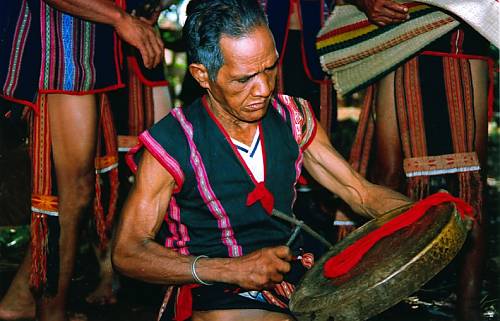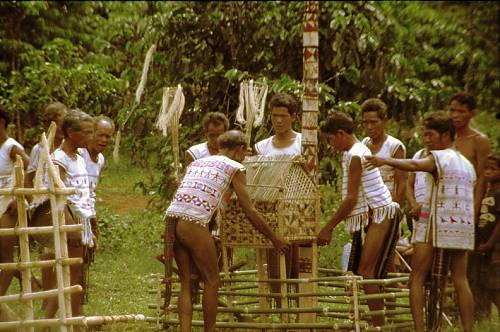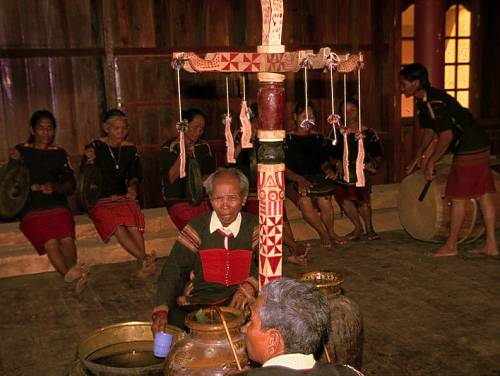المجال الثقافي الأجراس القرصية
سجل في 2008 (3.COM) على القائمة التمثيلية للتراث الثقافي غير المادي للبشرية (أعلنت أصلاً في 2005)
بلد(ان): فييت نام
تعريف
Description

- المجال الثقافي الأجراس القرصية
- © Institute of Culture and Information / Duong Thanh Giang
يغطي المجال الثقافي للأجراس القرصية في وسط الأراضي الفيتنامية الجبلية عدة مقاطعات وسبعة عشر مجتمعًا لغوياً-إثنياً، منها من يتكلم اللغة الاسترالية الآسيوية ومنها من لا يتكلم اللغة الاسترالية. وتشكل أنظمة معتقداتهم المرتبطة بشكلٍ وثيقٍ بالحياة اليومية وبدورة المواسم، عالمًا غامضًا حيث تُنتج الأجراس القرصية لغةً مميّزةً بين الرجال والآلهة والعالم الخارق للطبيعة. فوراء كل جرس قرصي يختبئ اله أو إلهة يصبح أكثر قوة كلما مرّ الزمن على الجرس. وكل عائلة تملك جرسًا واحدًا على الأقل، ما يدلّ على ثراء العائلة وسلطتها ومقامها ويؤمّن الحماية لها أيضًا. وفي حين تُستعمل مجموعة من الآلات الموسيقيّة النحاسيّة في العديد من الاحتفالات، إلا ان الجرس القرصي وحده يبقى موجوداً في الطقوس كلّها في حياة المجتمع وهو الآلة الرئيسة في الاحتفالات.
تختلف الطريقة التي يُلعب فيها على الجرس القرصي في الفييتنام بحسب كل قرية. فيحمل كلّ عازف جرسًا مختلفًا يتراوح قطره بين 25 و80 سم. ويتمّ اللعب على 3 وصولاً إلى 12 جرسًا قرصيًّا في القرية في مجموعاتٍ تتألّف من رجال أو نساء. ويتمّ اعتماد تدابيرَ وإيقاعاتٍ مختلفة لتتكيف وموضوع الاحتفال، نذكر على سبيل المثال التضحية الطقسية بالعجل ومباركة الأرز وطقوس الحداد. ويمكن شراء الأجراس القرصية الخاصة بهذه المنطقة من البلدان المجاورة ووضع النغمة المرغوب بها للاستعمال الخاص.
وقد أثَّرت التحولات الاقتصاديّة والاجتماعيّة بشكلٍ كبيرٍ على طريقة الحياة التقليديّة لهذه المجتمعات ولم تعد تؤمّن السياق الأصليّ لثقافة الجرس القرصي. فقد تمّ تشويه انتقال طريقة الحياة هذه والمعرفة والدراية بشكلٍ قاسٍ في خلال سنوات الحرب في القرن الماضي. أما اليوم، فقد تفاقمت هذه الظاهرة بسبب اختفاء الحرفيين القدامى واهتمام الشباب المتزايد في الثقافة الغربية. وقد جُرّدت الأجراس القرصية من معناها المقدس وباتت تُباع في بعض الأحيان لإعادة التصنيع أو تبدل مقابل منتجات أخرى.
عرض الشرائح
فيديو
يمكن استعراض مقاطع الفيديو هذه (بالإضافة إلى العديد غيرها) من خلال موقع أرشيف اليونسكو للملتميديا”
مشروع الحماية (06-2007/07-2009)
The main goal of this project is to safeguard the space of gong culture in one province of the Central Highlands of Viet Nam, Dak Nong Province. This project has been designed to develop a network of gong practitioners and enthusiasts and to support preservation and promotion of the Central Highland’s gong performance tradition in the actual cultural context where it was born and has been maintained in social life until today. The project will directly benefit the artisans, artists, the devoted people and caretakers who have greatly contributed to the safeguarding of the gong heritage, but will also benefit the broader Vietnamese people. By mobilizing all potential sectors from society, the project seeks to provide the foundations for transmitting the skills of playing and especially of tuning gongs to young generations, and to promote awareness of the significance of intangible cultural heritage not only at the local level, but also at the national level. It will include a systematic inventory of the practitioners of gong tuning and performance and establish a policy of recognition and valorization of older master artists.
The project’s goals are to:
- safeguard gong culture in the present social situation in which modernization and globalization are rapidly occurring, and young people’s aesthetic taste has increasingly been deflected from traditional heritage;
- assist ICH custodians and practitioners in their efforts to safeguard and transmit this heritage to future generations and to target young audiences and potential performers;
- raise the awareness of young people in the local community of the important role they should have locally and nationally in Vietnamese society at large by ensuring the conservation and transmission of the know–how of gong tuning and performing ;
- identify best practices in implementing the 2003 Convention on the Safeguarding of the ICH , in respect of community involvement.








